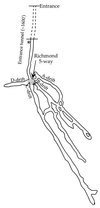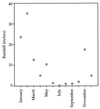Seasonal variations in microbial populations and environmental conditions in an extreme acid mine drainage environment
- PMID: 10427059
- PMCID: PMC91544
- DOI: 10.1128/AEM.65.8.3627-3632.1999
Seasonal variations in microbial populations and environmental conditions in an extreme acid mine drainage environment
Abstract
Microbial populations, their distributions, and their aquatic environments were studied over a year (1997) at an acid mine drainage (AMD) site at Iron Mountain, Calif. Populations were quantified by fluorescence in situ hybridizations with group-specific probes. Probes were used for the domains Eucarya, Bacteria, and Archaea and the two species most widely studied and implicated for their role in AMD production, Thiobacillus ferrooxidans and Leptospirillum ferrooxidans. Results show that microbial populations, in relative proportions and absolute numbers, vary spatially and seasonally and correlate with geochemical and physical conditions (pH, temperature, conductivity, and rainfall). Bacterial populations were in the highest proportion (>95%) in January. Conversely, archaeal populations were in the highest proportion in July and September ( approximately 50%) and were virtually absent in the winter. Bacterial and archaeal populations correlated with conductivity and rainfall. High concentrations of dissolved solids, as reflected by high conductivity values (up to 125 mS/cm), occurred in the summer and correlated with high archaeal populations and proportionally lower bacterial populations. Eukaryotes were not detected in January, when total microbial cell numbers were lowest (<10(5) cells/ml), but eukaryotes increased at low-pH sites ( approximately 0.5) during the remainder of the year. This correlated with decreasing water temperatures (50 to 30 degrees C; January to November) and increasing numbers of prokaryotes (10(8) to 10(9) cells/ml). T. ferrooxidans was in highest abundance (>30%) at moderate pHs and temperatures ( approximately 2.5 and 20 degrees C) in sites that were peripheral to primary acid-generating sites and lowest (0 to 5%) at low-pH sites (pH approximately 0.5) that were in contact with the ore body. L. ferrooxidans was more widely distributed with respect to geochemical conditions (pH = 0 to 3; 20 to 50 degrees C) but was more abundant at higher temperatures and lower pHs ( approximately 40 degrees C; pH approximately 0.5) than T. ferrooxidans.
Figures









References
-
- Edwards, K. J., T. M. Gihring, and J. F. Banfield. Unpublished data.
-
- Edwards K J, Goebel B M, Rodgers T M, Schrenk M O, Gihring T M, Cardona M M, Hu B, McGuire M M, Hamers R J, Pace N R, Banfield J F. Geomicrobiology of pyrite (FeS2) dissolution: a case study at Iron Mountain, California. Geomicrobiol J. 1999;16:165–179.
-
- Goebel B M, Stackebrandt E. The biotechnological importance of molecular biodiversity studies for metal bioleaching. In: Priest F G, Ramos-Cormenzana A, Tindall B J, editors. Bacterial diversity and systematics. New York, N.Y: Plenum Press; 1994. pp. 259–273.
Publication types
MeSH terms
Substances
LinkOut - more resources
Full Text Sources
Other Literature Sources
Molecular Biology Databases

